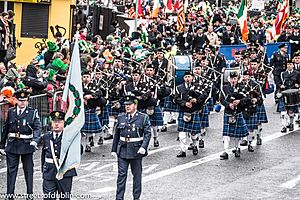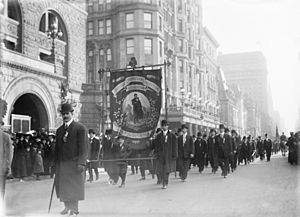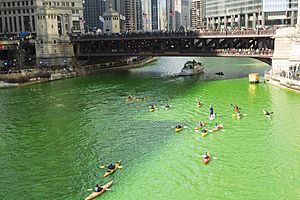Saint Patrick's Day facts for kids
Quick facts for kids Saint Patrick's Day |
|
|---|---|
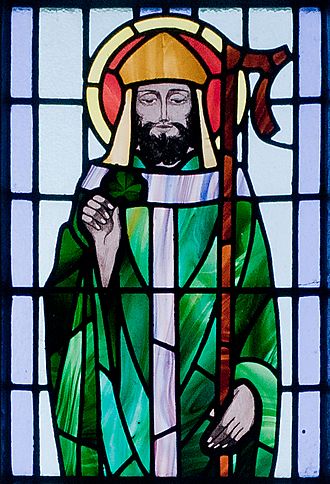
Saint Patrick depicted in a stained glass window at Saint Benin's Church, Ireland
|
|
| Official name | Saint Patrick's Day |
| Also called |
|
| Observed by |
|
| Type | Ethnic, national, Christian |
| Significance | Feast day of Saint Patrick, commemoration of the arrival of Christianity in Ireland |
| Celebrations |
|
| Observances | Attending mass or service |
| Date | March 17 |
| Next time | 17 March 2026 |
| Frequency | Annual |
Saint Patrick's Day (also called St. Patrick's Day or Paddy's Day) is a special day to honor Saint Patrick. He is the patron saint of Ireland, meaning he is a special protector for the country. This day is a big cultural and religious celebration for Irish people. It happens every year on March 17. People celebrate it all over Ireland and in many other places around the world. This includes places where Irish people or their families now live.
The celebrations are full of fun! You'll hear traditional Irish music. People also enjoy Irish beer and eat foods like bacon and cabbage. The color Green is very important for Saint Patrick's Day. It is the national color of Ireland. Many people wear green clothes or a shamrock (a small clover plant) on their outfits. A fun tradition is to gently remind friends who are not wearing green. The first Saint Patrick's Day parade in Ireland was in Waterford in 1903. New York City in the United States also has a very large parade.
Contents
Who Was Saint Patrick?
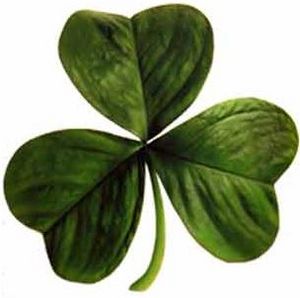
Patrick was a Christian missionary and bishop who lived in Ireland in the 400s. We know a lot about him from his own book, called Declaration. This book tells us about his life. He was born in Roman Britain in the 300s. His family was wealthy, and his father and grandfather were church leaders.
When Patrick was 16, Irish raiders captured him. They took him to Gaelic Ireland as a slave. He worked as a shepherd for six years. During this time, he became very religious. His book says that God told him to escape to the coast. There, a ship would be waiting to take him home. After he returned home, Patrick became a priest.
Patrick's Return to Ireland
Tradition says that Patrick went back to Ireland. He wanted to teach the Irish people about Christianity. His book explains that he spent many years sharing his faith in northern Ireland. He helped many thousands of people become Christians. Patrick worked hard against the old Irish religions. This effort later became a legend. The legend says he drove "snakes" out of Ireland. Ireland never had snakes, so this story might mean that Patrick helped remove the old religions from the country.
People believe he died on March 17, 461. He was buried in Downpatrick. Over the next hundreds of years, many stories grew about Patrick. He became Ireland's most famous saint.
How Saint Patrick's Day is Celebrated
Celebrations in Ireland
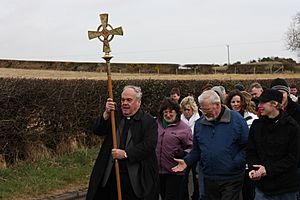
Saint Patrick's Day parades in Ireland started in the late 1800s. People felt a stronger sense of Irish pride then. This feeling helped inspire the celebrations.
The celebrations in Dublin have become very big since 1996. They are now a week-long event called St. Patrick's Festival. This festival includes amazing fireworks shows. There is also outdoor music, street theatre, and the traditional parade. Many Irish people wear a bunch of shamrocks on their coats or hats. Children often wear green, white, and orange badges. Girls traditionally wore green ribbons in their hair, and many still do.
The biggest celebrations in Ireland outside of Dublin are in Downpatrick. This is where Saint Patrick is believed to be buried.
Celebrations in the United States
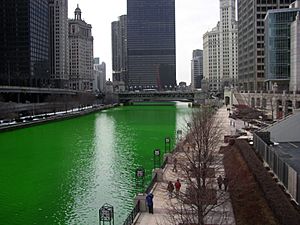
Irish immigrants brought Saint Patrick's Day celebrations to the United States. The first unofficial celebration was in New York City on March 17, 1762. Irish soldiers serving in the British army marched through the city. The smallest parade is said to be in Hot Springs, Arkansas. This parade is less than one city block long. Boulder, Colorado also claims to have a very short parade.
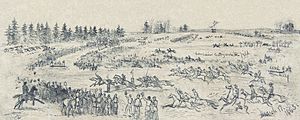
The first public Saint Patrick's Day celebration in the 13 colonies was in Boston, Massachusetts, in 1737. The first celebration in New York City was at the Crown and Thistle Tavern in 1756. Since then, the New York parade has become the largest Saint Patrick's Day parade in the world. More than 150,000 people march in it every year. The parade goes up 5th Avenue in Manhattan. About two million people come to watch the parade each year.
Sometimes, if March 17 is a Sunday, the New York parade is moved to the day before.
Some U.S. cities paint the lines on their parade routes green. Others, like Chicago, dye their major rivers green. Savannah, Georgia, which has the world's second-largest Saint Patrick's Day parade, dyes its downtown fountains green.
Here are some of the longest-running Saint Patrick's Day celebrations in the U.S.:
- Boston, Massachusetts, since 1737
- New York, New York, since 1756
- Philadelphia, Pennsylvania, since 1780
- Savannah, Georgia, since 1813
- Carbondale, Pennsylvania, since 1833
- Chicago, Illinois, since 1843
- New Haven, Connecticut, since 1845
- San Francisco, California, since 1852
- Cleveland, Ohio, since 1897
Celebrations in Canada
In Canada, Saint Patrick's Day is an official holiday in Newfoundland and Labrador. Some groups have tried to make it a national holiday for all of Canada.
The longest-running Saint Patrick's Day parade in Canada is in Montreal. This parade started in 1824.
In Quebec City, there was a parade every year from 1837 to 1926. The Quebec City St. Patrick Parade started again in 2010 after more than 84 years.
Toronto has had a parade since at least 1863. The Toronto Maple Leafs hockey team was once called the Toronto St. Patricks. They wore green jerseys from 1919 to 1927. In 1999, when the Maple Leafs played on Saint Patrick's Day, they wore green throwback uniforms. A large parade in downtown Toronto on the Sunday before March 17 brings in over 100,000 people.
Celebrations in Great Britain
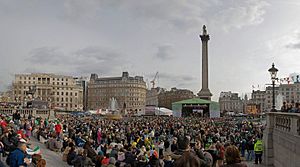
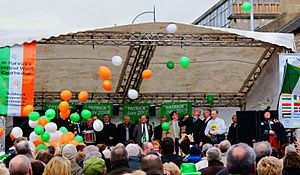
In Great Britain, the Queen Mother used to give shamrocks from Ireland to members of the Irish Guards. This is a special army group. The Irish Guards still wear a shamrock sent from Ireland on this day.
Other events happen in Great Britain too:
- Birmingham has the biggest Saint Patrick's Day parade in Britain.
- London holds a parade around March 17, often in Trafalgar Square.
- Liverpool has many Irish residents. It holds a Saint Patrick's Day celebration for Irish heritage.
- Manchester hosts a two-week Irish festival before Saint Patrick's Day.
- Horse racing at the Cheltenham Festival attracts many Irish people. It usually happens around Saint Patrick's Day.
Fun Facts About Saint Patrick's Day
- It's very rare to find a four-leaf clover. The chances are about 1 in 10,000.
- Leprechauns are tiny Celtic fairies. They are often linked to Saint Patrick's Day.
- The shamrock, a three-leaf clover, is said to have been used by Saint Patrick. He used it to explain the Holy Trinity.
- After a time of great hunger in Ireland, almost a quarter of the Irish people moved to the United States. At first, some people in the U.S. did not treat the Irish well.
- Corned beef and cabbage is a meal often eaten on Saint Patrick's Day. Poor Irish immigrants in the U.S. started this tradition. Corned beef was cheaper than ham, which they ate in Ireland.
- Legend says that each leaf of a four-leaf clover has a special meaning: luck, love, faith, and hope.
- Chicago first dyed its river green for the holiday in 1962.
Images for kids
-
Traditional Saint Patrick's Day badges from the early 1900s, from the Museum of Country Life in County Mayo.
-
Dublin's General Post Office and the Spire on O'Connell Street on Saint Patrick's Day.
-
Moscow hosts an annual Saint Patrick's Day festival.
-
Celebrations in Buenos Aires center on Reconquista street.
-
Astronaut Chris Hadfield wearing green in the International Space Station on Saint Patrick's Day, 2013.
See also
 In Spanish: Día de San Patricio para niños
In Spanish: Día de San Patricio para niños


